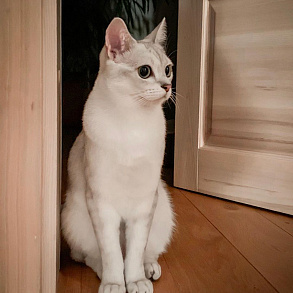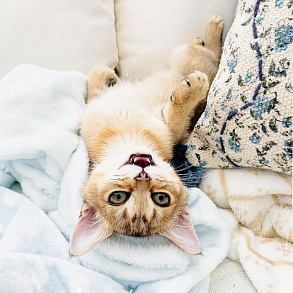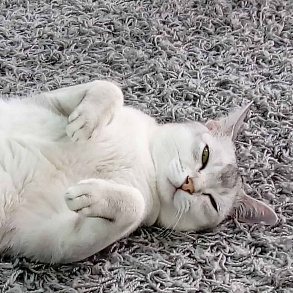Burmilla

Burmilla is a relatively young breed of cats bred in the UK and originating from Burmese and Persian chinchillas. The animals inherited the bright appearance of both ancestors, as well as unique smoky and shaded colors.
Brief information
- Breed name: Burmilla
- Country of Origin: UK
- The time of the birth of the breed: 1981
- Weight: 4 – 7 kg
Highlights
- Burmilla belongs to the category of rare image pets, which is one of the reasons for its high cost.
- Thanks to breed experiments, new varieties of burmills are periodically born, for example, semi-long-haired, golden. However, if you buy a cat with an eye to exhibition success, it is better to abandon such animals, since almost all of them have not received recognition from felinological associations.
- It is not difficult to maintain the glamorous look of the cat's fur, which will please owners who dream of a stylish pet that does not need to be looked after endlessly.
- Breeders call burmills "all-age" cats for their ability to get along equally well with both adults and children.
- This is one of the best breeds for single people of retirement age, since cats do not suffer from hyperactivity.
- Burmills are not afraid of water, although, unlike Turkish vans, they are not eager to take a shower.
- The breed is very peaceful and easily gets along with other pets, whether cats or dogs.
- The desire to contact people as often as possible leads burmills to the fact that at night they alternately visit each family member in bed.
Burmilla is an embodied charm with an easy-going nature and inexhaustible curiosity, suffering from a mild form of gambling addiction. The possession of this "fluffy ideal" is not only a matter of prestige, but also a test of perseverance in achieving the goal, since cats are not available for reservation on ad sites, and burmilli kennels in Russia are easy to count on the fingers of one hand. However, true fans of the breed are only stimulated by difficulties: in the end, there are still England and the USA, where a larger number of breeders who agree to air transportation of animals are engaged in breeding burmills.
Breed characteristics
History of the Burmilla breed
It is amazing, but the reason for the appearance of burmills was banal human carelessness. In 1981 , two purring cats of the Persian breed met in one of the English estates chinchilla named Sunquist, owned by Baroness Miranda von Kirchberg, and burmese cat Faberge. The animals were kept in different rooms waiting for mating partners, but one day the cleaner forgot to close the doors in the premises. As a result, the cats did not wait for the planned mating, solving the problem of further reproduction on their own.
Four healthy kittens of black and silver colors were born from the relationship of Sanquist and Faberge, which immediately aroused the interest of breeders. As a result, it was these four who participated in the first breeding experiments to create a new breed. When breeding burmillas, breeders immediately identified a goal: to get a Burmese-type cat inheriting an extensive palette of chinchilla colors. However, it later turned out that in addition to the exterior indicators, the character of newborn mestizos has also changed.
Curious fact: shortly after the arbitrary mating with the Burmese Faberge, the Sanquist cat was castrated and did not participate in breeding anymore.
Burmills were standardized in 1984, and ten years later received official FIFe recognition. The WCF Commission agreed to include the breed in the stud books in 1996. TICA joined it only in 2008. The last to register burmills was the American Felinological Association.
Video: Burmilla
Burmilla breed Standard
The predatory beauty of Burmese ancestors in Burmills is softened by the smoothness of lines. At the same time, the breed is not characterized by frank toyiness of appearance: the silhouette of burmills is graceful, and their wool does not add volume to the body, as it happens with chinchillas Persians . Cats look more charismatic than cats: a pleasant solidity to their appearance is given by developed, plump cheeks, as well as a more impressive build. In general, burmills have a more doll-like appearance than Burmese, but less comely than Chinchillopers.
Head
The head of the burmilla is a short blunt wedge with a soft rounded outline. Wide-set cheekbones stand out noticeably on the muzzle. The lower jaw and chin are strong, moderately developed. The profile has a clear transition without a hump.
Ears
Large ears with a wide set are noticeably tilted forward. The tips are slightly rounded, the base has a good width. The ears themselves visually continue the contour of the upper part of the muzzle.
Eyes
Burmills have wide-set and big eyes. The upper eyelids have a classic oriental shape, while the lower ones have rounded outlines. The standard color of the iris is green. Occasionally, amber color of the eyes is allowed in individuals of cream, tortoiseshell and red suits.
Housing
The bodies of burmills are more massive than it may seem at first glance. The size of cats is average. The backs of the animals are smooth on the segment between the croup and shoulders. The chest in profile looks rounded and has a strong structure.
Limbs
The legs of burmills are thin, with oval elegant paws.
Wool
The classic British burmilla is a short–haired cat with dense silky hair that is slightly raised due to the soft undercoat. In the 90s, the breed had a separate branch, represented by semi-long-haired cats. Breeding of such burmills is attributed to breeders from Australia, and the animals themselves are called Tiffany. To date, most felinological associations refuse to see Australian burmills as a breed as such. Nevertheless, the breeding of cats with long hair continues.
Color
Burmilla wool is necessarily tipped or shaded. The main breed suits are purple, brown, chocolate, black, speckled blue, cream, speckled black. There are individuals with a point color that forms a pattern on the muzzle in the form of a rhombus or the letter M. Sometimes golden burmills are born, but this color is recognized as permissible only by the Czech Association of Breeders.
Disadvantages and possible vices
Deviations that may affect the exhibition evaluation of the animal:
- different from the standard color of the iris in adult cats;
- cobby-addition and vice versa – excessive brownness of the constitution;
- shaggy ruffled wool;
- elongated muzzle.
Burmilla's character
Burmilla is a cat with a harmonious character, moderately independent, but at the same time, contact. In fact, all the typical feline habits have united in the breed, but in a somewhat "refined" form. For example, burmilla is extremely playful and just crazy about all kinds of teasers, as well as clockwork mice. At the same time, the passion for the pursuit of prey never goes beyond adequate behavior, so it will not sweep smartphones and fragile figurines from the table in the house.
Sociability and the desire for tactile contact with a person among the descendants of Burmese and chinchillas are very developed, so the burmilla will often ask for "pens", and he will "trample" on the master's knees with pleasure. However, one should not confuse sociability with stickiness: as soon as kotofey realizes that no one is interested in his tenderness, he will immediately stop annoying others with his claims.
Burmill is usually recommended to owners who value order in their own homes, as well as those who are worried about the safety of designer repairs. It is believed that representatives of this breed are careful in everyday life and do not sin with scratches, even if they are very out of sorts. Another distinctive feature of burmills is expressive purring, which the cat "turns on" at the first touch of its fur. Having such a musical pet is an advantage in itself, if, of course, you are ready to perceive sound vibrations as an alternative kind of anti-stress therapy.
Burmills are affectionate, and this fact is important to take into account. Unlike most of the tribesmen, the descendants of the Burmese get used not to the house, but to the person next to them. To give into the wrong hands an already adult cat, with whom it was not possible to get along, is at least cruel. It cannot be said that the representatives of this family are such desperate party-goers, nevertheless, loneliness has a depressing effect on animals. Accordingly, before buying a burmilla, you will have to make a final choice: either a career or a cat.
Education and training
Burmills are curious, intelligent and conflict-free pets, although not devoid of standard feline cunning. The latter quality is especially vividly revealed in situations when punishment looms on the horizon: the wronged "tail" skillfully depicts non-involvement in the dirty trick that has just been done and deliberately does not react to the calls of the owners. The rest of the Burmills are quite malleable and are almost always excellent students.
Adaptation of a kitten to new living conditions, as a rule, is painless. If you notice that the baby is too cowardly and cautious, make sure in advance: together with the animal, grab a toy or a diaper from the nursery that smells of his brothers and parents. Familiar smells will calm the pet and distract his attention. The fastest way to accustom the burmilla to a new home is to limit the area of its movement to one room, in which a tray, basket and bowl with food will be installed. Usually, after a day or two, the kitten is perfectly oriented in a previously unfamiliar room.
Burmills are extremely clean, so they do not have problems with going to the tray. You can teach your baby cat's wisdom with the help of special literature. Books are perfect: "Training a cat in 10 minutes" by Fields-Babino, "Raising your cat" by Tiling. In the process of training a variety of tricks, rely on the natural inclinations of the animal. For example, the breed is not indifferent to the aportirovka of objects and easily learns to bring prey on demand, but acrobatic numbers with high jumps the cat may not like.
Usually, adult burmills are not attracted to furniture upholstery, but kittens discovering the world are sometimes not averse to sharpening their claws on the sofa. To avoid trouble, first of all buy a scratching post, and then treat the areas attractive to the baby with essential oils. Stop attacks on furniture and wallpaper, even if it happens during the game: the ban should remain a ban in any situation. An excellent educational tool remains a spray bottle filled with water. If the kitten is too carried away with pranks, it is enough to arrange a light sobering shower for him.
Maintenance and care
The exquisite appearance of burmills creates a deceptive impression of their effeminacy and unsuitability. In fact, representatives of the breed perfectly get used to both apartment conditions and living in a country house with mandatory outings to the nearby territory. Even if you live in a megalopolis, do not be lazy to accustom a cat to a harness, going out with her for a walk in a nearby square or park. Burmilla only benefits from such excursions!
As for home maintenance, here you need to remember the main thing: burmills love warmth and always strive to attach fluffy corpuscles to heating devices. Accordingly, if you want to please the cat, buy a hanging couch and attach it to the battery in the cold season.
Hygiene and grooming
Maintaining the external charm of burmills requires minimal effort on the part of the owner. The short coat of the breed sheds very moderately, so if you do not forget to comb the purr at least once a week, cleanliness in the apartment is ensured. A little more often you will have to tinker with the pet's muzzle. First, try to immediately remove the mucous lumps from the eyes of the burmilla, with which the animal looks extremely untidy. Any clean lint-free cotton fabric is suitable for this, as well as saline, calendula decoction or a weak solution of boric acid (a teaspoon per 250 ml of water).
Secondly, wipe your chin if it is stained with food. The breed's wool absorbs any third-party pigments, so if it is not cleaned in a timely manner, the areas of the "fur coat" that have come into contact with the coloring substance will change the tone. Keep your pet's ears clean by removing the sulfur plaque, if it has really accumulated in excess. Once a week, it is useful for burmilla to brush her teeth, but it will be necessary to cultivate obedience in the animal during the procedure from an early age. If you suddenly want to "refresh" the oral cavity of an adult kitten who is not familiar with a toothbrush, do not count on his patience and loyalty.
Feeding
The most convenient option is to continue feeding the kitten with the food that he previously received in the kennel. To accustom the burmilla to a new type of food for her (dry food or natural food) is also realistic, but the transition will have to be carried out gradually. In addition, individual cats categorically refuse to eat unfamiliar foods, which is why some of the owners stop trying to change the diet and continue feeding the wards according to the previous scheme. A natural menu is considered a healthier option for burmills. Usually the nutritional value of a cat 's portion is calculated as follows:
- from 60 to 70% – meat and offal;
- 20-30% – vegetable component;
- 10% – cereals.
Animal protein is allowed only lean, so pork should not be in the pet's diet. Kefir with a fat content of 1%, ryazhenka, low-fat cottage cheese are useful for burmills from fermented milk products. Fish is offered to kotofeyam occasionally, and only in boiled form and without bones. The liver also needs heat treatment, since in most cases it is infected with parasites.
It is advisable to transfer burmilla to "drying" if you are not going to save on the quality of feed. Give up cheap options in which the amount of carbohydrates exceeds the protein content, as well as varieties in which dyes are added (croquettes are colored pink and green). An alternative to dry food is wet canned food, but even here you will have to study the composition beforehand. Do not feed the burmilla with meat jelly from bags, which contains a lot of soy, and the protein content is less than 10% per 100 g of canned product.
Health and diseases of burmills
The breed has excellent health, so genetic diseases remind themselves extremely rarely. Usually veterinarians recommend paying increased attention to the work of the burmilli kidneys, since it is this organ that is most susceptible to the formation of cysts leading to kidney failure. Some individuals may suffer from allergies, manifested in the formation of red spots behind the ears, on the temples and neck. Most often, the animal's body responds with an allergic reaction to chicken meat, so this product should be introduced into the burmilla diet with great caution.
How to choose a kitten
- If you take a kitten for breeding, keep in mind that the pedigrees from TICA presented by the breeder do not guarantee the thoroughbred of the animal. Please note that for the registration of offspring in this system, only the owner's statement is sufficient, while the examination of the litter by a specialist of the organization is not carried out.
- Track the schedule of Russian and international cat shows where rare breeds are exhibited. Attending such events gives a real chance to get acquainted with a reliable breeder and get in line for a purebred kitten.
- Try to buy a kitten from a seller who has his own producers. Mating with a burmilla cat "from the outside" is very expensive, so the breeder will try to compensate for the costs by increasing the price tag for offspring.
- In official nurseries, kittens are given to new owners after the burmills have turned 3 months old. With sellers offering burmills of a younger age, it is better not to have anything at all.
- It is not recommended to take the smallest kitten in the litter for breeding, but such babies are quite suitable as pets "on the sofa".
Burmilla price
Burmilla is a rare breed of cats not only in Russia, but also in the world, and therefore expensive. When buying a kitten from Russian breeders, get ready to spend from $500 to $700. Prices in American nurseries are almost the same: from 700 to 1200 dollars per individual.


